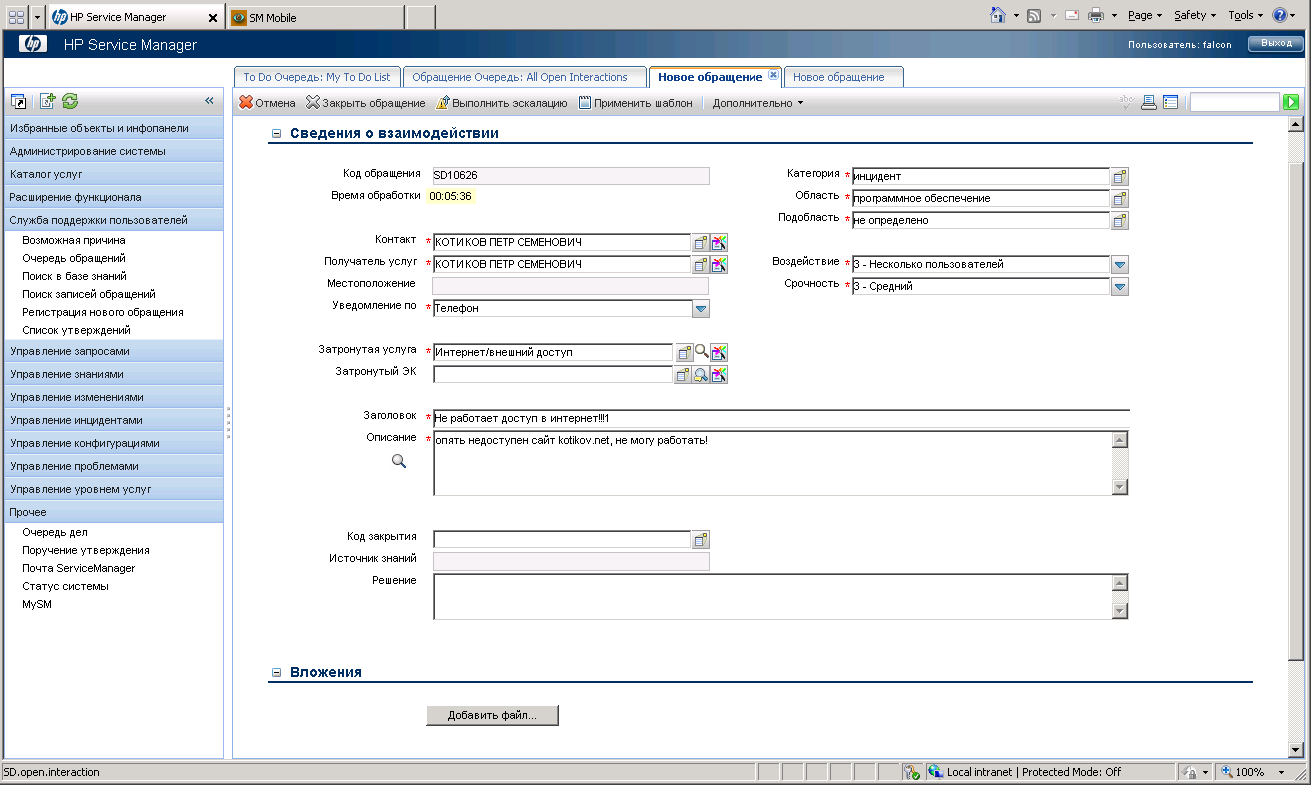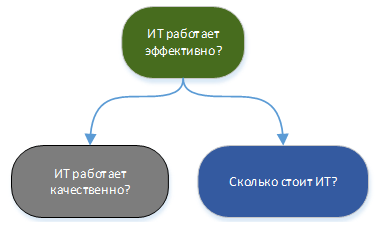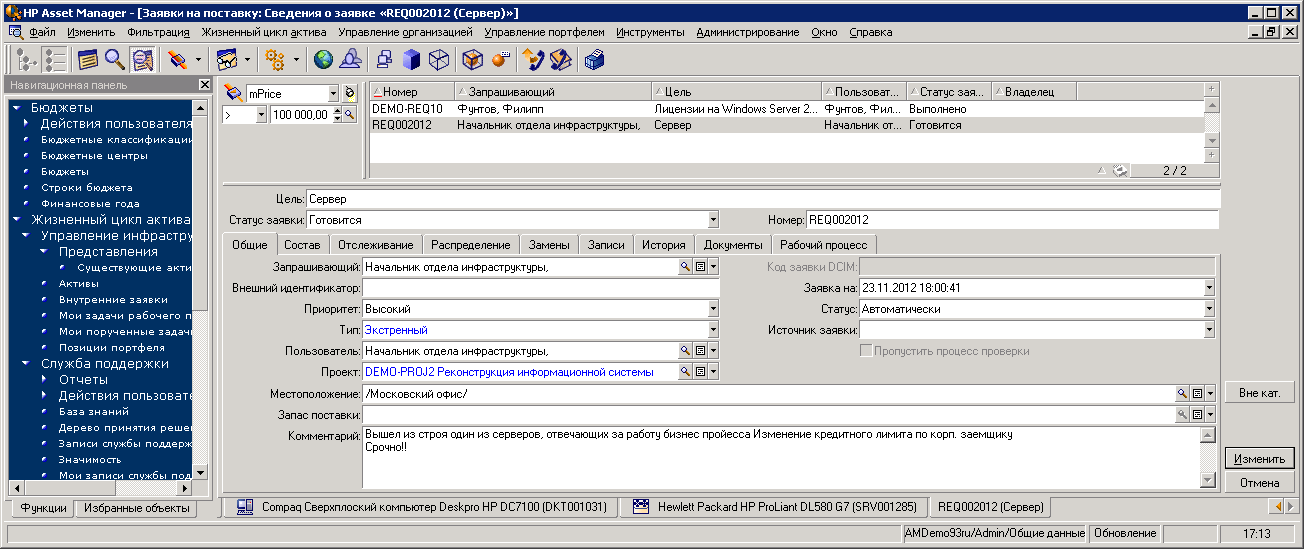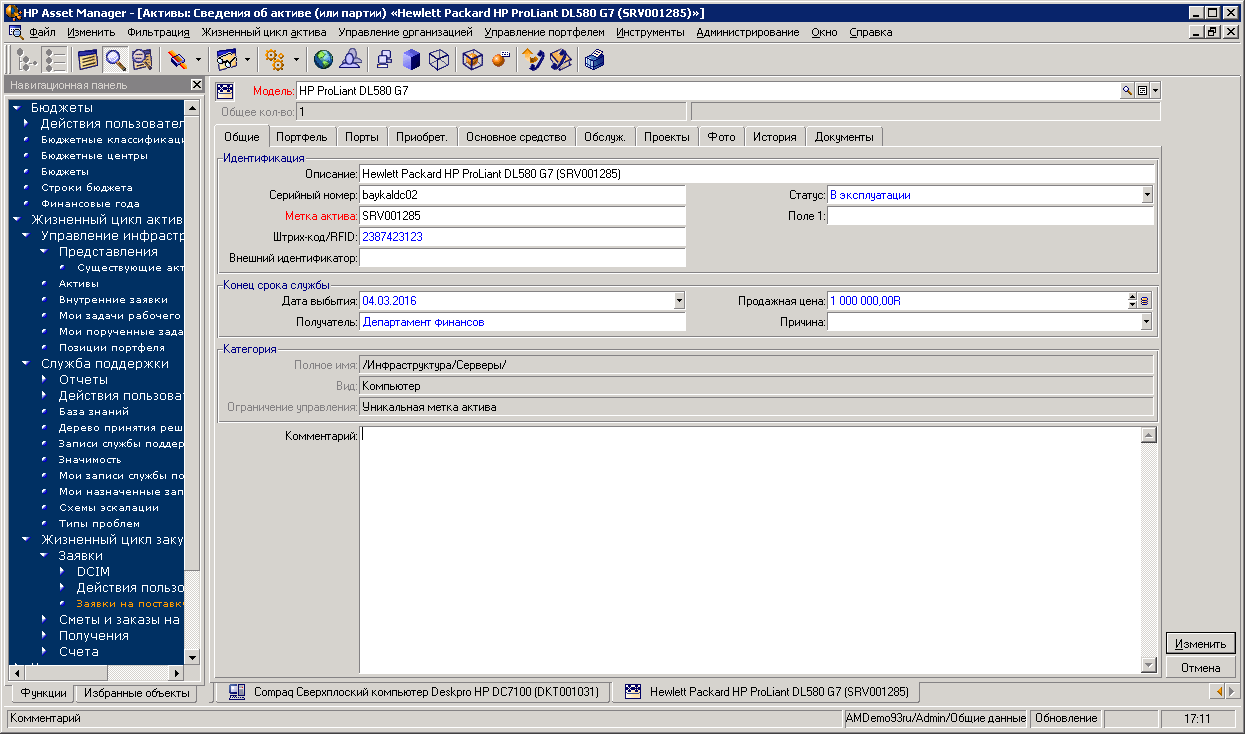Tools of IT departments of large companies: how to get rid of chaos and count every penny

Application form
Imagine that you come to a large company to manage an IT department, and you understand that there was simply no horse lying around . In the simplest case, you have from 50 people, a lot of papers about purchases and movements, inventory inventory of equipment ... and, perhaps, everything.
The first task with which the analysis of chaos begins is the audit of departments / processes and work with the most important and inhibiting ones. I want to know exactly how failures are solved - a system of ticket incidents is started ... I want to automate most of the tasks - the system of tickets acquires the functionality of business rules. I want users to unload the support - and now they have their own tools for generating requests, and such that sending a request without filling in all the necessary data is simply not possible.
')
The next level is to understand what IT should do and in what time frame - a catalog of services and agreements with the business appear; where is the server, the license, how are they used - discerning and accounting system; who has access to what, who should coordinate changes, how much it costs to provide each IT service. The final is a clear understanding of IT costs and the ability to clearly / quickly explain to the business where his money goes. And at the same time and how much it will cost his new Wishlist.
As a result, the IT department, designed to automate the work of the company, also automates its work. Naturally, to solve such problems there is a special ready-made software. About him and talk.
Frequent problems:
- “Somehow” everything works on historically established principles. Nobody documents anything, in case of a difficult situation they ask or decide on places. Automation is unsystematic, they could have done it.
- There is no area of responsibility of specific specialists - they answer all-for-all or none-for-that.
- There are a couple of people whose care will be thrown by the department a year ago.
- Financial processes are not described, everything is done “somehow” or on the basis of spontaneously established processes.
- Asset accounting is done in such a way that you can draw anything;
- Everybody believes that they are working well and with all their might, while the business regularly makes complaints. And it genuinely surprises your subordinates.
- The tasks of control are unrealistically heavy.
The situation described is extreme, but I bet that some points will exactly match.
And here you need to remember that the goals and objectives of your work have already been agreed upon when applying for a job, and the current situation hardly contributes to this. Suppose, in general terms, your goals will sound like this - to ensure the effective operation of IT; or reduce IT costs by 10% without dropping quality; or prepare to take over a smaller company (along with its IT); or all at once.
Everything, with the theoretical introductory finished, go to the practice. To understand how effectively IT works, you only need to answer 2 questions:

How well does IT work?
How many unnecessary movements? Do I need to improve the quality? What is with the loading of everyone in the department? Do we still need licenses for Windows Server 2012?
To understand how well IT works, you need to have some guidelines. As such, best practices are commonly used - ITIL, Cobit, ISO 2000, and so on. These are the very concepts that for the first time were puzzled by the effectiveness of the organization of IT work and laid down the basic principles that are now widely used throughout the world. It is these concepts that recommend identifying entities such as processes and IT services in IT activities and building the work of IT departments around them. But what are processes if they are not automated (unless, of course, we are in an enterprise at the beginning of the 19th century)?
What about infrastructure?
How do we change the infrastructure and how will we coordinate it? “Why is there no virtual machine on this hypervisor? a month ago was
How do we collect and store infrastructure information? “And where was she transferred then?”?
How exactly does this server affect users? - “We have fallen off the server vbs.company.ru! mm ... so what? "
Questions weight. The solution is the organization of processes with an eye on the best practices (the same ITIL), which will allow to structure the work and make their implementation effective. And then comes the understanding that you need somewhere to take the software, which will help to combine all this in one solution ...
Step 1: Process Management
- The process begins with an incident and ends with its decision.
- Each application has its own priority. For example, accounting applications during the delivery of the declaration are more important than the problems of the storekeeper Vasya. The server must be repaired before the access to the Internet by Antonina Petrovna. It would be nice if most of the priorities were set automatically - that is, you need to describe each one and assign it a value.
- A task can be automatically assigned to an employee who is able to solve it in accordance with priority and classification.
- Each task has a responsible person at each stage.
- If someone slows down, an alert for the manager is generated about this.
- If somewhere something goes wrong (for example, mice run out of stock), an alert is generated about this too. Or a new ticket is automatically created. That is, there is automation and a system of rules.
For any change that the user wants, there is a matching rule: he wants the mouse - the default is apruvim; wants a new laptop - a letter to the manager; need to move software - approval of the person responsible for the service. How much work falls off when the simplest statement comes in between the asked-done wedges.
Users see on the portal what equipment and services they are entitled to, we have information from someone who uses what to contact. - Each process is divided into subtasks that are easy to complete. For example, the process of “putting a computer into an accountant’s workplace” and the process of “putting a computer into a developer’s workplace” already contain a description of software licenses and where to get them inside the company.
- All documents are processed automatically. If you move a computer from a warehouse, then a record of this is required.
- Where you can do something out of order, the process is parallel.
Perfect, right?
Moreover, the good news is: since your IT department is not the first in history, all this is already very well described and documented. But there is a nuance. Ideally, it still does not fall on reality. Each company will always have its own specifics, which cannot be changed just like that. For some, specialists are less confused, they need fewer fields, otherwise they will fill up for a long time; for others, the management wants to conduct detailed analytics on requests, so you need to put it on the form “this and this”. A banal example - the specificity of the customer required that all available information about the user be displayed on the application form (phone number, address, position, his manager, and 3-4 more fields) so that the operator could see her as quickly as possible. Usually, the user is simply indicated and details can be opened if necessary. And now the ready solution must be finished, prescribing new rules. That is, such that the service management system is “out of the box” without file modification in place, I never remember.
Want to try and pick it up? We have a HP Service Manager in the solution center. My colleagues can list a couple more analogues, but I work with him, he appeared in Russia back in 2007-2008, and, in fact, still remains the only product covering all the needs of IT departments.

On the screen again, the application form
Asset Management
The next stage of chaos in IT is neponyatki with what we have, where it is and how we use it. The fact is that very often IT assets are held in accounting as ordinary assets. In practice, this means that in your company there may be a lot of "depreciated", but in fact working iron, it is not clear where and how the used licenses plus a lot of other surprises.
To remove the chaos, they take and collect a single database of all documents where the necessary IT assets may be mentioned:
- All warranties.
- All supply contracts.
- All inventory documents and all movement history.
- All license agreements.
- Information about iron-license configurations.
- Information about who has what iron (name and phone numbers of employees, for example).
Then, naturally, they organize the process of keeping all this up to date: it’s banal that you cannot write off or pay for the contract if they are not in the database. Unregistered pops up at the moment.
Among other things, this approach allows you to not miss the deadline for the completion of a guarantee or support of something important. In my practice, a couple of times the customer had a situation when critical equipment failed, and it turned out that there was no one to fix it. The first time and so unpleasant idle time increased several times while searching for a counterparty and carrying parts. The second time, a simpler solution was the purchase of a new iron at all in exchange for the failed one, which in one fell swoop spent a significant part of the IT budget and launched an internal investigation.
Where is the money, Johnny? How much is IT?
One of the most serious questions to the IT department, which arises more and more often - how much is the provision of a service to a company? In theory, this can be counted one-time, although the procedure is not fast. But adult IT departments make automated accounting systems that allow you to understand the situation almost in real time.
For example, you have a mail platform. There are licenses for the virtualization platform for mail, there is the cost of equipment and support. You write the formula yourself as to whom to count - for example, accounting for boxes, volume marketing, directorate - a fixed amount once a month - and so on. You can take into account each call support, traffic overspending, all Wishlist, and so on. Formulas are not necessarily fair (as they are set by hand), but they give an understanding on whom to hang the money.
And when your bank, your retail or your insurance opens a new branch, you can clearly say: “Everything in our unit will cost 243 dollars per employee per month.”
Again, in my practice, such a system leads to the fact that appeals for support come in on business, plus unused equipment returns on time. When the head of each unit understands what and how much it costs (and this money hangs automatically in its budget), it becomes much easier.
We solve this and the previous task of HP Asset Manager. It also integrates with the ticket system to obtain data on the movements of values within the company and internal accounting for each action. Again, I repeat, colleagues will call several analogs, but it is I who, in my work in practice, observe such a bundle.

"Morning traffic light" - each task is deployed to any level of detail

Sample server purchase order

Sample asset card
Subtotal
Already good, right? Everything is taken into account until the last bolt, nothing is lost anywhere, there is financial planning, it is always clear from internal accounting. Old problems with tickets on time and confusing processes have already been forgotten. Teaching new Padawans is easy - login to the service manager, and then he himself assigns tickets in the right order and tells what to do.
So now you can exhale. And those who are better off are moving to the next stage of automation to engage in really interesting tasks.
Is IT working efficiently?
The third level of work is not only to organize processes and automate them, but also to centrally control their work, while spending a minimum of time on it and not tugging at the managers. Here we will be helped by the balanced scorecard, which will show in numbers how the work of a department, department or a specific manager corresponds to the tasks set.

The scoring architecture allows you to get the necessary information from unstructured data
The HP Executive Scorecard balanced scorecard is a tough enough thing, not always needed. There are many other tools to control the quality of work, but consider the tool for her example.

HP Executive Scorecard main interface
Here is an example of a scorecard for which COO (Chief Operating Officer) is the Operations Director for IT. Indicators are not on a separate activity, but on the activities of the unit as a whole. Using the example, the COO should draw a parameter from the “Operation” group and it can detail it to composite KPIs and see what exactly is broken:

A good side effect of using the balanced scorecard is that leaders understand which of their tasks are key. And what are the unambiguous criteria for their assessment. Did not appear during the year - a bonus. And if there are problems, then at least they will be immediately visible.
Total
From the beginning of the 2000s, TOP-200 domestic companies come to a similar scheme of work, starting to build the work of their IT departments in the following way: first, tickets, so that nothing is lost and clear priorities; then other processes, management of the service catalog, configuration changes ... then - an accurate understanding of exactly how much it costs and what proportion of IT projects in each project of the company; And only recently, IT management began to come to an integrated quality control of the IT department through balanced indicators.
At our center of HP solutions, this entire ecosystem is deployed on demo databases (IT simulator of a large company) - if you are interested to see, come or write to vfeldchun@croc.ru. I repeat, the world has not come together with HP, but we have their solutions in the center, and my long-term practice is also connected with them, so if something is interesting, I will answer and tell you more.
Source: https://habr.com/ru/post/227655/
All Articles